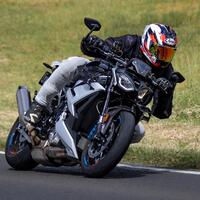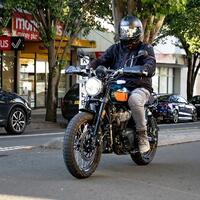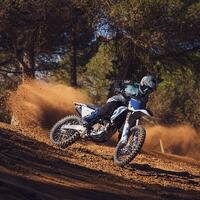
Rain, rain go away, come back another day. This is what I was remonstrating as my time with Yamaha’s WR250F and WR450F rolled into the second of their two-week stay. A deluge had befallen Sydney, flooding creeks and turning the foothills of the Blue Mountains into slippery hell-pits of bog.
With the forecast forbidding and no chance of a break, I made the call to run my review of Yamaha’s blue — but soon to be brown — WRs on my home test track. I’m lucky enough to have seven acres with a built-in Thumpernats-style grass track. It wasn’t immune to the rain either, and what followed was a mud bath of epic proportions. I wouldn’t be climbing rock faces or threading snotty single track, but mud has its own lessons to teach.
If you’re looking for a no-holds-barred shootout with some young fit unit in tight nylons dragging bars through bottomless berms, look elsewhere. What I am is an older (not old) guy who used to ride plenty of enduro and MX before being distracted by fast sports bikes and long-range adventure machines. Lately, me and a few mates have rekindled the dirt love — and the camaraderie that comes with it. So, if you’re looking to get into off-road riding, or returning after a long spell, this review may just help.

Before diving into how each WR handled the mud-soaked debauchery, let’s break down what makes them tick.
The WR250F copped a complete overhaul in 2025, adopting the YZ250F’s chassis as its foundation. That update delivered a slimmer, lighter machine with a lower centre of gravity, revised suspension, sharper ergonomics and improved airflow management. Yamaha claimed it turned quicker, tracked straighter, and delivered strong, linear power across the range.
For 2026, changes are minimal, the big one being a new lockable ECU — basically, if someone nicks your bike you can immobilise it via Yamaha’s Power Tuner app.
Specs stay the same: a 249cc liquid-cooled DOHC four-stroke single with fuel injection, a wide-ratio six-speed box, fully adjustable KYB suspension (300mm front, 306mm rear), 7.4L fuel capacity, and 113kg wet weight.
The WR450F had its last major rework in 2024, when Yamaha slimmed it down, dropped about 2kg, and sharpened the whole package. Minor tweaks came in 2025, and for 2026 it too gets the lockable ECU.

It runs a 450cc liquid-cooled DOHC single with fuel injection, wide-ratio five-speed gearbox, the same KYB suspension travel as the 250, 7.4L tank, and weighs 117kg wet.
Both bikes hook into Yamaha’s Power Tuner app for fuel and ignition mapping and fine-tuning traction control, which offers three levels including OFF. They connect wirelessly via a built-in communication control unit, while a tidy set of buttons on the left switchblock lets you flick between two maps on the fly. Traction control can only be adjusted through the app.
Yamaha’s WRs also carry something else — a hard-earned reputation for bulletproof reliability in the toughest enduro conditions. For new riders and returnees, that peace of mind matters.
I’ve been in the market for an enduro bike for a while. Being a solid lad, I’ve always craved the punch of a 450. But with years of riding behind me, I know I’d be quicker, less intimidated, less exhausted — and less likely to maim myself — on a 250. After riding these two back-to-back, I’d say that still holds, but it’s not as clear-cut as I thought.

Thanks to modern mapping, both bikes can be tuned to suit conditions. On a day like this, an old-school 450 would’ve been a nightmare, but with mapping at your fingertips, you can tame the beast, and the 450 was surprisingly easy to ride in the filthy slop — in fact, in some instances it was easier. That’s not to say that the 450 is for the faint-hearted; given free rein and plenty of throttle, this thing will tear your face off, man. It’s an animal when you want it to be, but years of evolution and revolution have produced an engine that is quite tractable and infinitely predictable.
The 450 felt more stable in ultra-slick corners, its extra weight allowing the front knobby to dig past the slime to firmer ground underneath. And with that being the case, I preferred riding the 450 in the filthy conditions — until the inevitable happened and I dropped the sucker, which I did with savage regularity. Then the scales tipped back in the 250’s favour. There’s not a huge weight difference, but when you’re picking your bike up for the 100th time, every kilo counts.
On the rare bits of track that offered some semblance of grip, the 250 is certainly easier to punt hard. It’s simply less work, less intimidating and less tiring to ride fast, especially on a tight and twisty track like mine, and that’s going to be even more the case if you want to hit single trail stuff. Both bikes have a sharpness about them, and given your body position is in check, it’s amazing just how hard you can jam both bikes into a turn. With that said, if the 450 is a knife, then the 250 is a scalpel.

Now, that may sound like the 250 is a slug, but that couldn’t be further from the truth. Unlike competition-ready 250 enduros of the past, the WR250 packs great punch off the bottom, a howling top end and gutsy mid-range. With grip at your disposal, it’ll simultaneously throw kilos of roost and point its front wheel skyward, all while feeling predictable and under control. It really is a delight to ride fast and is the master of finding your limits in the dirt, with enough in the closet that you’re not going to outgrow it.
Being based on the MX platform, both bikes are ultra slim with a nice flat seat that allows you to get your weight where it’s needed. The two bikes don’t feel overly different to sit on and with both bikes covered in filth I had to wipe some mud off the decals to see which machine I was on. Once you’re rolling you can feel the difference in weight, but it’s not dramatic — certainly the difference isn’t as marked as years gone by when quarter-litre enduros were twitchy, rev-happy missiles that needed constant attention to keep the engine on the boil, and when an open-class enduro bike meant a scary, lumbering thing that would cause you to evacuate into your underpants.

I still reckon 95% of riders are better off on a 250 — if their ego can handle it. I get it: rock up with your mates on a 250 while they wheel out their 450s, and you feel like you’ve brought a knife to a gunfight. But let your riding do the talking. For most average riders, the 250 will get through the bush quicker, and you’ll be far less cooked when you roll back into camp.
That said, if you’re into wide-open country or like screaming across desert terrain, the 450 rules. And with Yamaha’s tuning options, the gap is narrowing. You can dial the 450 down until it’s friendly, turn traction control on for backup, or unleash it when you’re ready. If you’re a bigger rider and not fazed by a few extra kilos, the choice between 250 and 450 is less obvious than it once was.


























